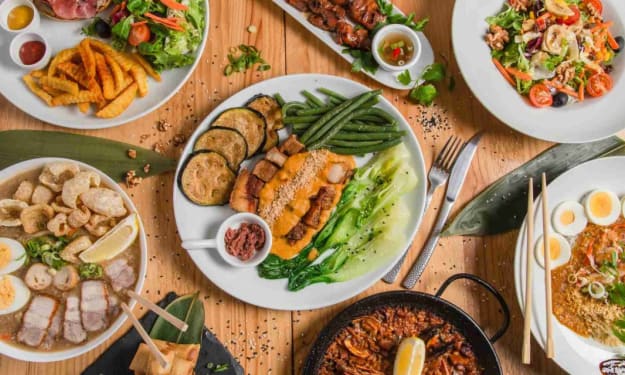The "Champagnes" of the Food World
How Geography & Place Shape What We Eat

Most of us are familiar with Champagne, along with other drinks like Bourbon and Scotch, whose very existence and identity is defined by geographical origins. If your sparkling wine does not come from France’s Champagne region, then it is not Champagne; it is merely sparkling wine. There’s a vast array of alcoholic beverages that are identifiable strictly by their provenance, the importance of their place of origin. But what you might not know is that the food world is very much the same. Much like alcoholic beverages, there are both international and regional legal mechanisms that have been put in place to protect the provenance of various foods. This ranges from cheeses (the kingpin of global food provenance and geography-based protections), to tea, to potatoes, and across all corners of the globe, from Roquefort-sur-Souizon, France, to Yunnan in China, to Idaho in the United States. This list is by no means exhaustive, but rather it is merely a glimpse into the extremely important role that geography and politics play in the foods we eat every day. These are some of the "Champagnes" of the food world.
The Legal Mechanisms that Protect Food Provenance
In legal terms, the idea of food provenance is, at the most basic level, referred to as geographical indication, or GI; internationally, this is the most commonly-agreed upon term used to refer to geography-based food origins and protections. It is important to note that GI and its associated protections are distinct from trademarks and their legal protections. However, in different regional arenas where food provenance is regulated, GI sometimes assumes other names. The European Union (EU) has three distinct classifications for GI protections: Protected Destination of Origin (PDO), Protected Geographical Indication (PGI), and Traditional Specialties Guaranteed (TSG). PDO refers to goods originating from a specific region or regions, PGI classifies goods that originate from a specific country, and TSG protects goods that hold a specific identifiable "character." Similarly, Articles 22 and 23 of the World Trade Organization (WTO) Agreement on Trade-Related Aspects of Intellectual Property Rights (TRIPS) from 1995 aim to protect GI goods from imitation and misleading geography-based labeling. The EU and WTO offers large-scale bodies under which foods’ provenance can be protected, however, smaller bodies also offer such protection, albeit in smaller jurisdictions. Protections may be provided by governments, but more commonly are the product of regional organizations and committees that exist in specific jurisdictions and may be devoted to a specific product or product range. A combination of large- and small-scale GI protections creates a massive global mechanism devoted to the provenance of the foods we eat worldwide.
Cheese

Source: Pexels.
Perhaps surprisingly, cheese comprises the most significant-sized segment of provenancially-protected foods. But at the same time, it is perhaps not surprising given the nature of how cheese is produced. Cheese is made from the fats and proteins of various animals’ milk, creating a diverse assortment of flavours and textures. Therefore, the geographical origins, type of animal milk, and production processes greatly impact the product output. All of these geography-based elements make each type of cheese unique. While there are literally hundreds of cheeses with protected GIs, here are a few of the better-known varieties.
Asiago - A hard cheese, sometimes likened to parmesan, Asiago is made from cow’s milk, exclusively from cattle in the alpine areas of Italy’s Veneto and Trentino-Alto regions.
Comte - Comte is a semi-hard cheese made from unpasteurized cow’s milk, with a geographical indication limiting it to the Jura Mountains, a medium-sized mountain range in the North of the Alps in Eastern France.
Edam Holland - Edam Holland is a low-fat, semi-hard cheese made exclusively from the milk of Dutch cows, and originating from Edam in the Netherland’s Northwest. It is important to note that when it first became protected by the EU in 2010, the term "Edam Holland" was used as opposed to simply Edam, which is not a protected name.
Feta - Feta is a brined cheese originating from Greece, made with either exclusively sheep’s milk, or a combination of sheep’s milk and up to 30% goat’s milk. Interestingly, Denmark also had a "Feta" cheese made with cow’s milk, but the EU granted PDO for Feta strictly to Greece.
Gorgonzola - This sharp-flavoured blue cheese is made from unskimmed cow’s milk, and originates from an extensive, yet exclusive list of regions in northern Italy: Novara, Bergamo, Brescia, Como, Cremona, Cuneo, Lecco, Lodi, Milan, Pavia, Varese, Verbano-Cusio-Ossola, and Vercelli.
Gouda Holland - Gouda Holland is a hard cheese made from the milk of Dutch cows; it originates from the Town of Gouda in the Netherland’s South Holland province. Much like Edam, 2010 EU law specified that "Gouda Holland" is a protected name, while "Gouda" is not.
Gruyere - Gruyere is a hard cheese made from cow’s milk. It originally came from the Fribourg, Vaud, Neuchatel, Jura, and Bern regions of Switzerland, however it is now unique among most other cheeses as its classification, PGI, encompasses the entire country and not just those five regions. Gruyere cheese has drawn some controversy outside of Switzerland, as some imitations have labelled their similar cheeses as French or Austrian Gruyere, however neither are considered to be true Gruyere cheese.
Mozzarella di Bufala Campana - More commonly known as Buffalo Mozzarella, Mozzarella di Bufala Campana is made from the milk of Italian water buffalo. Much like Gruyere, the protected PGI classification of Buffalo Mozzarella covers all of Italy, and not one particular region, as its milk is sourced from water buffalo across the country.
Parmigiano-Reggiano - Most commonly known as parmesan cheese, particularly in North America, Parmigiano-Reggiano cheese originates from the Parma, Reggio Emilia, Mantua, Modena, and Bologna regions of Italy. It can be distinguished from other non-GI makes of parmesan cheese by its pin-marked name, found on the rind of each true Parmigiano-Reggiano cheese wheel.
Roncal - Roncal is a hard but creamy cheese made from raw sheep’s milk. It originates from the Valle de Roncal in North Navarre, in Spain’s Basque region. Roncal cheese is produced solely from the milk of the Rasa and Lacha breeds of sheep, and even more specifically, is only made between December and July each year.
Roquefort - This very specific type of blue cheese originates from Roquefort-sur-Souizon in the Southwest of France. It is made with sheep’s milk, strictly from the Laucon breed of sheep.
Other Foods

Rooibos Tea.
Source: Veg Kitchen.
While no other food group has the same extent of GI-protected status as cheese, there is great diversity in the range of other foods that enjoy geography-based protections. Lubecker Marzipan, a unique German cake, has EU protected status to be made only by four manufacturers in the North German town of Lubeck: Niederegger, Corstens, Lubeca, and Marzipan-Land. In the United States, Idaho potatoes are labeled and protected by the Idaho Potato Commission. In Italy, San Daniele Prosciutto can only be produced in Northeastern Italy’s hilly Fruili Venezia Giulia region, from the uniquely "guitar-shaped" meat of Italian pigs. Numerous teas also enjoy protected status, including Puer Tea, which comes strictly from China’s Yunnan province, and the popular Rooibos Tea, made from the Redbush leaves for which it gets its name, only in the Western Cape province of South Africa.
Outside of food and alcoholic beverages, geographical provenance also plays a key role in the upscale water industry, although none of the major water companies have been given geography-based protection in the same way that whiskeys, wines, or cheeses have. However, provenance plays a key role in the identities of each brand’s water. San Pellegrino sparkling water is sourced from the San Pellegrino Terme in Italy’s Bergamo province, from what Leonardo da Vinci once called "miraculous" water. Perrier, another sparkling water, comes from Vergeze in the Gard Department of Southern France. Also from France, Evian mineral water is sourced from Evian-les-Bains on the shores of Lake Geneva, in the heart of the French Alps. Spa Water, a mineral water that has found popularity across Western Europe, is sourced from Spa, Belgium, in the Hautes Fagnes plateau region. While these distinct waters do not enjoy protected status from the EU or other bodies, they still sustain a monopoly in their respective geographical domains based on their provenancial distinctions.
A Cautionary Tale

Oka Cheese.
Source: The Globe and Mail.
Buyer beware: while many products will claim a unique geographical origin, not all enjoy GI protection, and in some cases, geographical uniqueness has been convoluted, or even outright altered. Take, for example, Oka, a Canadian cheese that has been marketed across the country as a uniquely Quebecois traditional cheese. While this is partly true—Oka cheese originated in the town of Oka, in Quebec’s Laurentian mountains, made by Trappist monks—the rights for this cheese were sold in 1996, and is now made in several different locations across Canada, while still being labelled as Oka cheese. Another prime example is Valencia Oranges, which, despite its name for the town in the Southeast of Spain, actually originated in California in the mid-1800s. And the popular hair treatment Moroccan Oil? You guessed it: not actually Moroccan, but rather a commercialized modification of Argan Oil, which is in fact from Morocco. This is why legal protections for geographically unique products is so important. Consumers are often not fully informed of the origins of their food, or even sometimes misled, and despite consumer-conscious efforts to raise awareness, GI often becomes convoluted. But thanks to the work of the EU, WTO, and several smaller-scale bodies like the Idaho Potato Commission, all working in tandem to legally protect the provenance of unique foods, the Champagnes of the food world can continue to thrive.
About the Creator
Logan Carmichael
Political Science grad. Aspiring diplomat.
There's hidden politics behind the food you eat, and I'm here to tell you about it.






Comments
There are no comments for this story
Be the first to respond and start the conversation.